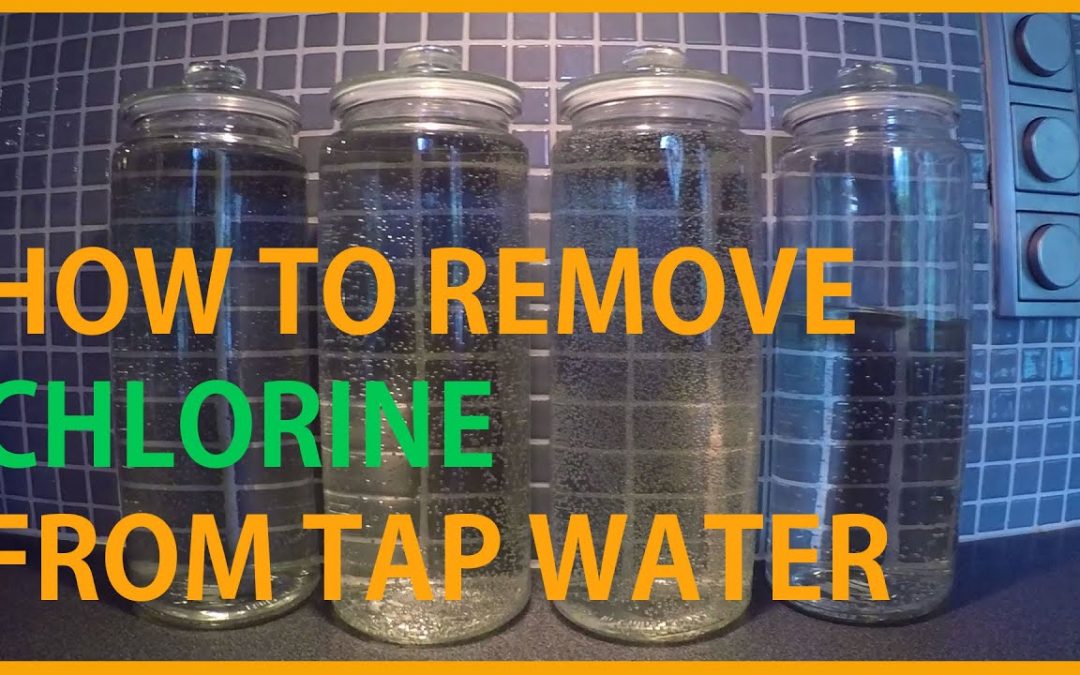A layer of chlorine or chloramine protects most public water systems. Knowing how to remove chlorine from water is very important. You can remove the shield at the faucet, but boiling the water for 15 minutes is not very effective. You’ll need to let the water cool before you drink it. That’s because chlorine and water have different boiling points, so boiling will only neutralize one part of the problem. However, there are other methods you can use to get rid of the chlorine from water, including boiling for 30 minutes.
How do you get the chlorine out of the water quickly?
One of the easiest ways to remove chlorine from water is by evaporation. Chlorine is an extremely volatile chemical, so evaporation is a great way to remove it. Chlorine molecules scatter when exposed to a change in temperature, so the temperature of the air and the water you’re using will affect how quickly the chlorine is removed. Water that’s at room temperature will evaporate chlorine more quickly than water that’s been left in a refrigerator for an extended period.
Another way to remove chlorine and chloramine from water is to use vitamin C. Vitamin C is a highly effective disinfectant used in filters placed under a sink or on a showerhead. It comes in two forms, sodium ascorbate, and ascorbic acid. Chlorine is also extremely volatile, and evaporation is the most effective way to remove it. Some municipalities have already begun using vitamin C filters in their drinking water to combat chloramine.
What neutralizes chlorine in the water?
Lemon juice and slices are natural remedies for neutralizing chlorine. Citrus fruits contain concentrated amounts of vitamin C. It is believed that vitamin C can neutralize chlorine in water, and sanitary engineers have begun using it in drinking water and drinking fountains. Even a small amount of lemon in water can make a difference. You can even ask for lemon wedges when ordering water in a restaurant. This simple remedy can reduce the amount of chlorine in water by up to 99%.
Besides being toxic, chloramine is also harmful to your health. It can affect your immune system and is even a cause of cancer. Therefore, you must boil water before using it. Chloramine can cause problems in warm-blooded animals and humans alike. It can also harm wildlife and the food chain. In addition to damaging your health, chloramine is also known to cause genetic damage in mammals. It is one of the most common causes of cancer.
Does boiling water remove the chlorine?
Boiling water can remove free chlorine but not chloramine-containing compounds. Chloramine is added to drinking water to prevent bacteria from growing in the water supply. Although boiling does remove chlorine, it will not remove fluoride. A better option is to leave water in a pot overnight to allow the chlorine to dissipate.
The process of boiling water to remove chlorine from water is a great way to dechlorinate small amounts of water quickly. However, if you’re using the water for drinking or cooking purposes, boiling water will take a lot longer. There are more practical methods for large-scale dechlorination. If you’re concerned about chlorine levels in your water, reverse osmosis or whole-house water filters can remove the chemicals in the water.
Using a high-powered boiling machine can help reduce chloramine levels. A UK bottled water study found that a five-minute boil removed about half of the chloramines. For larger-scale use, boiling is not feasible. To completely remove chloramine, you must boil water for a long period. But boiling will not be effective if you disinfect a large water volume.
How do you get the chlorine out of the drinking water?
Chlorine is a chemical element in tap water and many European countries. Most municipal water treatment plants use it as a disinfectant, but many people don’t want it in their water, particularly because it kills fish and other organisms. Water can be removed from chlorine in several ways. One method is to allow water to stand for some time. Chlorine will evaporate from standing water once the air temperature is warm enough.
Another effective way to remove chlorine from water is by boiling it. The chemical chlorine evaporates from water quickly when heated to high temperatures, but it will leave some chloramine in the water. You can also boil water for 15 minutes to remove chlorine. Boiling the water will also remove chloramine, but it won’t remove the chemical chloramine, which can clog pipes and lead to leaks.
How to remove nitrate from tap water?
Although nitrates are necessary for people’s health, elevated levels can pose a serious health risk, especially to infants. Nitrate poisoning can lead to serious health problems, including blue baby syndrome and shortness of breath. There are various methods to remove nitrates from drinking water, and the following information will help you decide which one is right for you. Fortunately, most nitrate-contaminated drinking water is not harmful.
Reverse osmosis, ion exchange, and electrodialysis are some of the methods that are commonly used for nitrate removal. Reverse osmosis is popular for this purpose, as it typically dissolves water in reverse. Reverse osmosis typically removes about 83 percent of nitrates, while a lower percentage stays within acceptable limits. An ion exchange unit is another common way to remove nitrates from drinking water as a softener. While ion exchange units are not widely used in households, they are effective for small quantities of nitrates.
If you live in a region with high nitrate levels, consider removing the source. If you live in a rural area, nitrate levels in your water are more likely to be higher than those in a city or town. While nitrates are common in many urban areas, they are mainly found in agricultural and industrial runoff, often untreated. Eventually, nitrates and nitrites find their way into drinking water through sewage plants and damaged disposal tanks.
What home remedy will free chlorine water?
The best way to reduce the level of chlorine in your water is to use a chemical that can neutralize chlorine, like potassium metabisulfite. These chemicals can be purchased in small tablets that dissolve in water. They are effective for lowering chlorine concentration but are more expensive. You can also use a chemical like chlorine bleach to remove high chlorine levels. But which chemical should you use? Read on to learn how to neutralize chlorine and which method will work for you.
Some natural remedies for chlorine can be found in your kitchen. Potassium metabisulfite is the most effective way to eliminate chlorine from water. This chemical is commonly used in wineries and breweries because of its effectiveness. You can purchase a bottle for under $20 to remove chlorine from 20 gallons. Another solution is to leave a gallon of water out for 24 hours. This solution will slowly evaporate chlorine from the water.
Is drinking chlorinated water harmful?
Recent studies have linked the chemical THM byproducts created by chlorination with cancer. These chemicals are known carcinogens associated with gastrointestinal disease and have been linked to a higher risk of bladder and rectal cancer. Studies are ongoing, but there are many reasons to stop drinking chlorinated water. Also, learn why drinking water that contains THMs is bad for you.
Fluoride is found in a variety of types of water. One study in Norway looked at 141,000 births in three years. They found that those women who drank water with higher levels of THMs were more likely to have a child with a congenital disability. Other studies have linked chlorine to increased kidney, bowel, and bladder cancer risk. However, spina bifida has not been linked to this chemical. Still, British water industry experts haven’t dismissed these findings.
The chemical trihalomethanes present in water from most of the United States are linked to an increased risk of heart disease, cancer, and allergies. Trihalomethanes are produced when chlorine reacts with organic matter. Earlier, this chemical was thought to be responsible for causing allergies, but recent studies show that chlorination is also linked to a higher risk of birth abnormalities. This finding has led to a global shift in the water supply.
Does filtered water have chlorine?
In the United States, chlorinated water is found in virtually all taps. It is commonly used in food and beverage manufacturing and is a key component of regular table salt. While chlorine benefits water quality, some studies have linked it to various health problems. Skin irritation and cancer may occur as a result of chlorination. It is also a byproduct of disinfection. In addition to its potential health hazards, chlorine is associated with several other harmful chemicals. The filter comprises an organic carbon block that provides both activated and catalytic carbon. Because chloramine has a small molecular weight, it cannot be removed by a typical carbon filter but must be removed by a catalytic carbon filter.
Chlorine is effective against most waterborne pathogens but is ineffective against Cryptosporidium. In addition to its bactericidal effects, chlorine is cheap, easy to monitor, and widely available. Because of its effectiveness against bacteria, it is a common disinfectant in public water systems. However, the use of chlorine in filtered water does have its drawbacks. Chlorine kills germs by penetrating slime coatings, disrupting cell walls, and disintegrating microorganisms’ DNA. One of the most efficient chlorine and chloramine removal techniques is activated carbon. Due to the sulfur and sodium components, both chemicals can increase the number of dissolved solids in the water.
Conclusion
Remember that drinking high amounts of chlorine won’t automatically lead to severe health problems. Only when you drink chlorinated water for prolonged periods can you experience some adverse health effects. The chlorine in water can be removed through chemical neutralization. Consider using a reverse osmosis system to purify your water supply. You can also try boiling water to remove chlorine from the water. An activated carbon filter removes municipal water’s strong flavor and impurities. Activated charcoal is used in traditional water filters. Consequently, removing chlorine and chloramine from drinking water can be a good idea.



